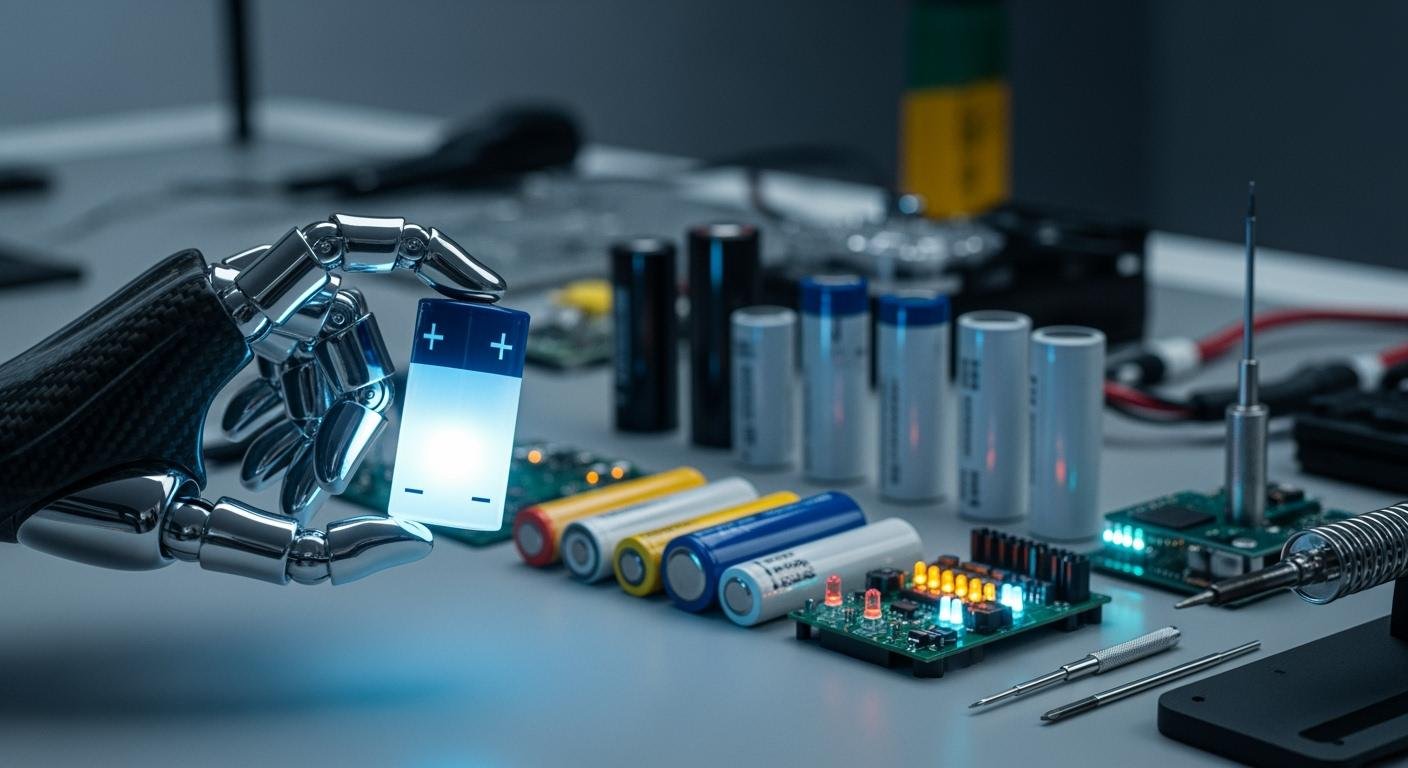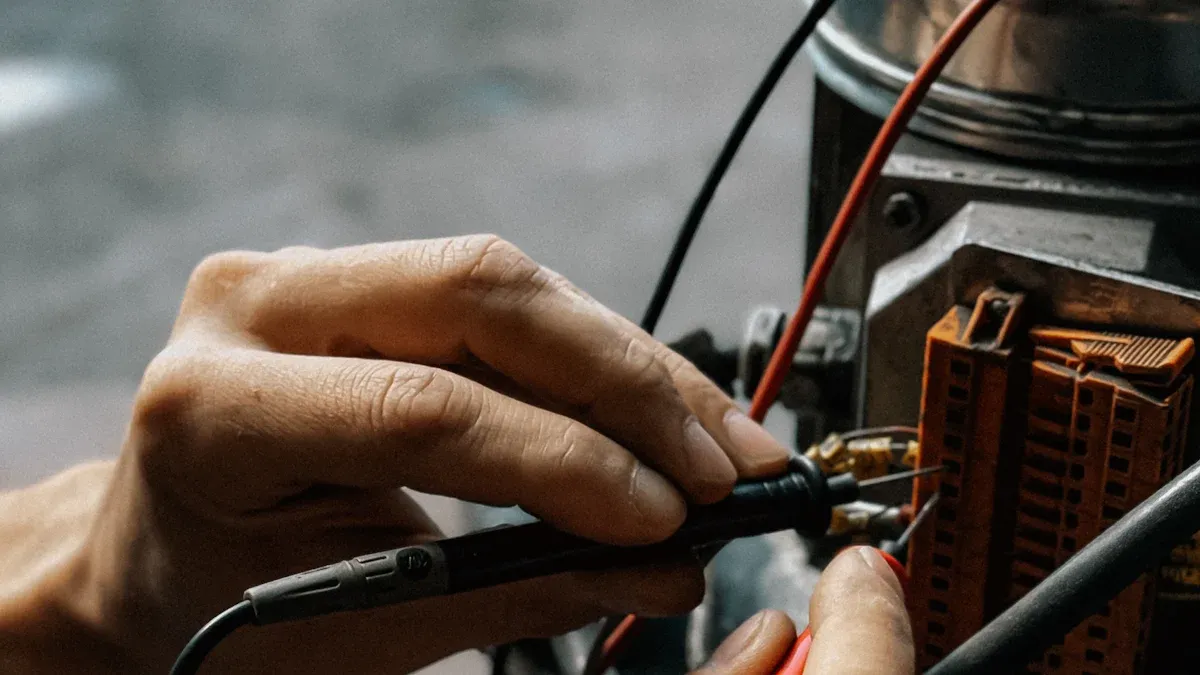
The best lithium battery is the one perfectly matched to your industrial robot’s mission. The market for industrial lithium-based batteries is expanding over 12% annually, making your choice critical for success.
💡 Pro Tip: For most applications, your ideal choice will be a quality Lithium Iron Phosphate (LiFePO4) or NMC lithium-ion battery. These lithium batteries provide excellent performance.
This guide helps you choose the right battery to ensure your robot operates safely and reliably.
Step 1: Choose the Right Lithium Battery Chemistry

Your first decision is choosing the correct chemistry for your robot’s job. The two leading options for industrial applications are Lithium Iron Phosphate (LiFePO4) and Lithium Nickel Manganese Cobalt Oxide (NMC). Each offers distinct advantages. A quality lithium battery pack starts with the right cells.
LiFePO4 for Heavy-Load Robots
You should choose a LiFePO4 lithium battery for demanding, continuous-use applications. This chemistry provides exceptional safety and a long lifespan. LiFePO4 batteries are highly resistant to thermal runaway and can endure over 3,000 charge cycles. This makes them a cost-effective choice for heavy machinery. Their robust nature is perfect for equipment like automated guided vehicles and aerial lift platforms that operate all day. These lithium batteries ensure your large-scale operations run smoothly and safely.
NMC for a Lightweight Mobile Industrial Robot
For a smaller mobile industrial robot, you need a different solution. An NMC lithium battery is the superior choice when size and weight are critical. NMC offers a higher energy density, meaning you get more power from a smaller, lighter battery pack. This quality is essential for agile automated mobile robots and inspection drones that require speed and maneuverability. The lighter weight improves efficiency and extends operational range.
💡 Quick Comparison: The right lithium-ion chemistry depends entirely on your robot’s mission. This table breaks down the key differences.
| Caractéristique | NMC Battery | LiFePO4 Battery |
|---|---|---|
| Densité énergétique | High (better acceleration) | Low (superior energy retention) |
| Sécurité | Lower risk (prone to thermal runaway) | Excellent (puncture-resistant) |
| Cycle de vie | ~800 cycles | 3,000+ cycles |
| Service Life | 2-3 years (high-power use) | 10+ years (long-term economy) |
Choosing between these lithium-ion technologies sets the foundation for your robot’s performance and reliability.
Step 2: Define Power Needs for Your Industrial Robot

After choosing your chemistry, you must define the precise power requirements for your industrial robot. A battery pack is more than its chemistry; its electrical specifications determine performance. You need to match the battery’s voltage, capacity, and discharge capabilities to your robot’s operational demands.
Calculate Required Capacity (Ah)
First, calculate the required battery capacity in Amp-hours (Ah). This value tells you how long the lithium battery can supply a certain amount of current. You can find the right capacity with a simple formula.
Formula for Capacity:
Capacity (Ah) = Current Draw (A) x Desired Runtime (h)
For example, if your robot draws 10 Amps and needs to operate for an 8-hour shift, you need a large-capacity lithium battery of at least 80 Ah. Always add a 20% buffer to account for efficiency losses and battery degradation over time.
Verify Voltage and Discharge Rate (C-Rate)
Next, confirm the voltage and discharge rate. The voltage of the battery pack directly impacts motor torque and speed. A higher voltage system can reduce current for the same power output, improving efficiency in certain applications. Ensure the voltage aligns with your motor’s optimal performance window to avoid overheating and premature wear.
The discharge rate, or C-rate, measures how quickly a lithium battery can deliver its energy.
- 1C: A battery discharges its full capacity in one hour.
- 5C: A battery discharges five times its capacity in one hour (or its full capacity in 12 minutes).
High-power applications like rapid acceleration or heavy lifting require a high C-rate. However, operating at high C-rates generates more heat and can shorten the life of your lithium-ion battery pack. You must balance performance needs with longevity.
Check Size and Weight Constraints
Finally, consider the physical dimensions. The size and weight of lithium batteries are critical, especially for mobile robots. A heavier lithium battery reduces the robot’s available payload and increases its energy consumption to move. Your chosen lithium-ion battery must fit within the robot’s chassis without compromising its structural integrity or center of gravity. For many industrial uses, a lighter battery pack improves overall efficiency and extends runtime.
Step 3: Key Safety for Your Lithium-Ion Battery
Beyond performance, you must prioritize the safety of your lithium-ion battery. A failure can cause significant downtime and damage. A quality battery pack integrates multiple layers of protection to prevent common risks like thermal runaway, short circuits, and mechanical deformation.
The Essential Battery Management System (BMS)
A robust Battery Management System (BMS) is the brain of your lithium battery and is non-negotiable. It actively protects the cells and ensures a long lifespan. You should ensure your BMS provides these critical functions:
- Overcharge and Over-discharge Protection: It keeps the battery pack within a safe voltage range.
- Temperature Monitoring: It prevents the lithium-ion battery from operating in extreme heat or cold.
- Short-Circuit and Overcurrent Protection: It disconnects the battery to prevent damage from abnormal electrical loads.
- Cell Balancing: It ensures all cells in the battery pack charge and discharge evenly. This function is vital for maximizing usable capacity and extending the battery’s service life.
Critical Safety Certifications
Certifications are your proof that a lithium battery has passed rigorous safety tests. You should look for these key standards for industrial applications:
- UL 2580: This standard tests for safety against electrical, mechanical, and thermal abuse. It is essential for batteries used in vehicles and robotics.
- UN 38.3: This certification is required for the safe transportation of lithium batteries. It ensures the battery can withstand shocks, vibrations, and pressure changes.
- IEC 62133: This global standard covers the general safety of rechargeable lithium-ion batteries.
Effective Thermal Management
Heat is a primary enemy of lithium batteries. The optimal operating temperature for charging is between 5°C and 45°C (41°F to 113°F). Operating outside this range degrades performance and poses safety risks. A quality design manages heat effectively. This prevents overheating, which can lead to catastrophic failure. Your chosen battery pack must have a system to dissipate heat generated during high-power use.
Step 4: Evaluate Quality and Charging Strategy
Your final step is to assess the manufacturer’s quality and define a charging plan. A superior battery pack is the result of excellent manufacturing and smart usage. These factors directly influence the safety, reliability, and lifespan of your investment.
Assess Manufacturer and Cell Quality
You must choose a manufacturer with a proven commitment to quality. The performance of your battery pack depends on the integrity of its internal cells and assembly. A reputable supplier demonstrates its quality through several key indicators.
- Proven Experience: They have a long track record of producing reliable products.
- Strict Quality Control: They adhere to standards like ISO 9001 and perform rigorous testing at every stage, from raw materials to the final battery pack.
- Advanced Technology: They use modern production facilities with automated systems for precision and consistency.
- Customer Support: They offer strong warranties and responsive after-sales service.
A top-tier manufacturer ensures quality by testing every component. This includes verifying cell capacity and internal resistance, using laser systems to confirm weld integrity, and conducting vibration tests on the finished battery pack. This meticulous attention to detail guarantees a safe and durable product for your industrial applications.
Optimize Your Charging Strategy
How you charge your lithium battery directly impacts its operational life. For many robotic applications, opportunity charging is an effective strategy. This method involves charging the battery in small increments during natural pauses in operation, such as between tasks. This keeps the robot in service longer and maximizes uptime.
💡 Pro Tip: For daily use, you can extend your battery’s life by charging it to 80% instead of a full 100%. This simple practice reduces stress on the lithium-ion cells.
To further optimize your charging routine, always use a charger designed for your specific battery. When storing the battery pack for extended periods, keep it at approximately 50% charge in a cool, dry environment. Following these guidelines preserves battery health and ensures you get the most value from your equipment.
Your Final Checklist:
- Match chemistry (LiFePO4/NMC) to the task.
- Define power, size, and weight needs.
- Confirm a quality BMS and safety certifications.
- Select a quality manufacturer and plan your charging.
Following these steps ensures you select the right lithium battery. This choice directly improves your robot’s uptime and reliability, enabling continuous operation. A quality lithium battery is essential for safe and efficient performance, guaranteeing your robot achieves its full potential and operational success.
FAQ
What is the main difference between LiFePO4 and NMC?
You should choose LiFePO4 for safety and a long lifespan in heavy-duty robots. You should select NMC for its lightweight, high-energy design in smaller, agile robots. Your robot’s job determines the best chemistry.
Why does the C-rate matter for my robot?
The C-rate tells you how fast a battery can discharge. A high C-rate is necessary for tasks requiring quick bursts of power, like fast acceleration or heavy lifting. You must match the C-rate to your robot’s peak power needs.
Can I use a lithium battery without a BMS?
No, you should never use a lithium battery without a Battery Management System (BMS).
The BMS is essential for safety. It protects against overcharging, overheating, and short circuits. It also balances the cells to extend the battery’s life.
What is the best way to charge my robot’s battery?
You can extend your battery’s life by not always charging it to 100%. For daily use, charging to 80% reduces stress on the cells. Also, use a charger specifically designed for your battery chemistry and voltage.

